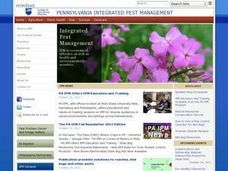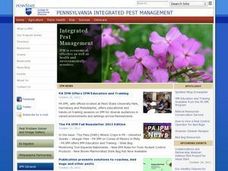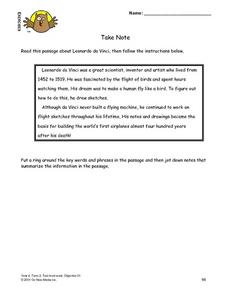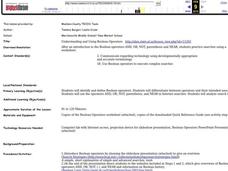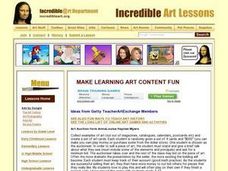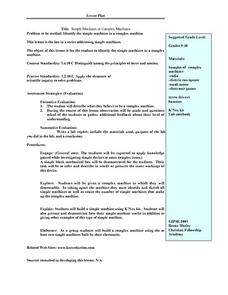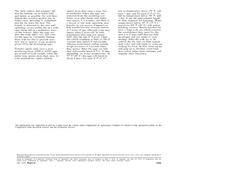Curated OER
Arthropod Key
Students identify the types of pests and categorize them. They identify their food chain and create a poster showing the food chain for the pests.
Curated OER
Bug Time
Students identify basic pest they find in the school yard. They discover and examine pest control. They also explain the benefits and risks of pests. High school students present a short lesson to third graders.
Curated OER
Bats -- Pests or Pals?
Fourth graders examine a bat and determine if it is a pest or pal. They identify three types of bats native to the state of Pennsylvania. They also identify the parts of a bat and write a report on the bat of their choice.
Curated OER
Invasion of the Habitat Snatchers!
Fourth graders investigate invasive plants found in a park or school environment and acknowledge the problems caused by the plants. They describe 4 methods of control of invasive plants.
Curated OER
IPM Basics
Fourth graders recognize that the term "pest" has a social connotation. They distinguish between good pest management practices and poor pest management practice and demonstrate knowledge of the IPM pyramid.
Curated OER
Spiders are Special
First graders recognize that spiders are important natural predators. They work in small groups with simple field guides to identify as many of their spiders as they can.
Curated OER
What's Hiding in Your Home Cabinets?
Students analyze a variety of products found in their own homes to determine their toxic content. They identify words such as caution, warning or danger and relate them to their relative toxicity levels.
Curated OER
Weeds-Wild and Wonderful
Students compare and contrast weeds and desirable plants. They explore the ways which their ancestors used weeds and depended on them for food and other household necessities.
Curated OER
Take Note!
Students take notes on information they find on the Internet or from other sources. They determine how to avoid plagiarism when gathering information needed. They discuss basic issues and consequences relating to responsible use of...
Curated OER
Understanding and Using Boolean Operators
Students identify and define Boolean operators. They differentiate between operators and their intended uses. They use the operators AND, OR, NOT, parenthesis, and NEAR in Internet searches and analyze search results. They use...
Curated OER
Passport to the World
Eighth graders investigate the process for obtaining a United States passport. They plan a trip to a foreign country looking at important information including the climate, geography, culture, money, and language. They complete the...
Curated OER
Art Auction
Students participate in a variety of activities that present art history. They arrange an art auction where each student serves as auctioneer to present a favorite piece. Students keep track of their accounts and bid to buy desired...
Curated OER
Food or Fuel?
Students describe the process of transesterification utilizing chemical formulas. They construct and compare models of chemical structure of the substances involved in biodiesel production such as: alcohols, alkenes, alkanes, alkyls,...
Curated OER
Chemical Formulas and Naming
Students practice naming and writing formulas for simple chemicals. After a review of vocabulary, they create ion flash cards and discuss the rules for writing chemical compounds. They practice naming and writing the formulas based on...
Curated OER
DNA in a "Snap"
Students observe a model of DNA and answer probing questions like, "What does this model represent?" They then work in small groups to construct an accurate model of DNA per rubric provided and present to the class explaining their model...
Curated OER
Shells and Subshells
Students explore how to show evidence of subshells and electron filling on the visual scale. They examine subshell filling and evaluate unknowns based on the atomic emission spectrum. Students design an experiment to identify colors of...
Curated OER
Snow Day
Eighth graders work in small groups to design and build a snow remover while looking at a snow design brief. They combine 2 or more simple machines to form a compound machine following the design brief in order to meet the required...
Curated OER
Simple Machines In Complex Machines
Students brainstorm the concept of a machine. They make lists of the characteristics that all machines share. The teacher uses questioning in order to get students to think more deeply about the subject. They create a lab to demonstrate...
Curated OER
Solution Concentration
Young scholars determine differences in concentrations. They have to state the problem they feel exists, consider possible solutions, and develop a plan to come up with for containers whose labels have fallen off. Students base this...
Curated OER
Keyboard Skills
Students are exposed to the basics of keyboarding. They use the keys for each hand without moving to the opposite sides of the keyboard. They also identify the enter/return key, the shift key, and the space bar. They recognize the...
Curated OER
Designing in Microsoft
Students review the basic formatting in Microsoft Word. Individually, they use the program to design a flyer for a baseball game. To end the lesson, they print them out, present them to the class and given a grade based on a rubric.
Curated OER
Channel Catfish
Students study the life and biology of the Channel Catfish. In this aquatic biology lesson, students will examine the external and internal features of the catfish along with their breeding habits and environment. This lesson includes...
Curated OER
Anticipation
Students predict events in Strega Nona. In this anticipation lesson, students use an anticipation guide to generate predictions about events in the story, Strega Nona. Students work independently to finish the guide as an assessment.
Curated OER
Describing Family - Lesson Plan
Students describe their family in their new language French. They use adjectives, and proper gender. Then they describe how the family is alike and different.




